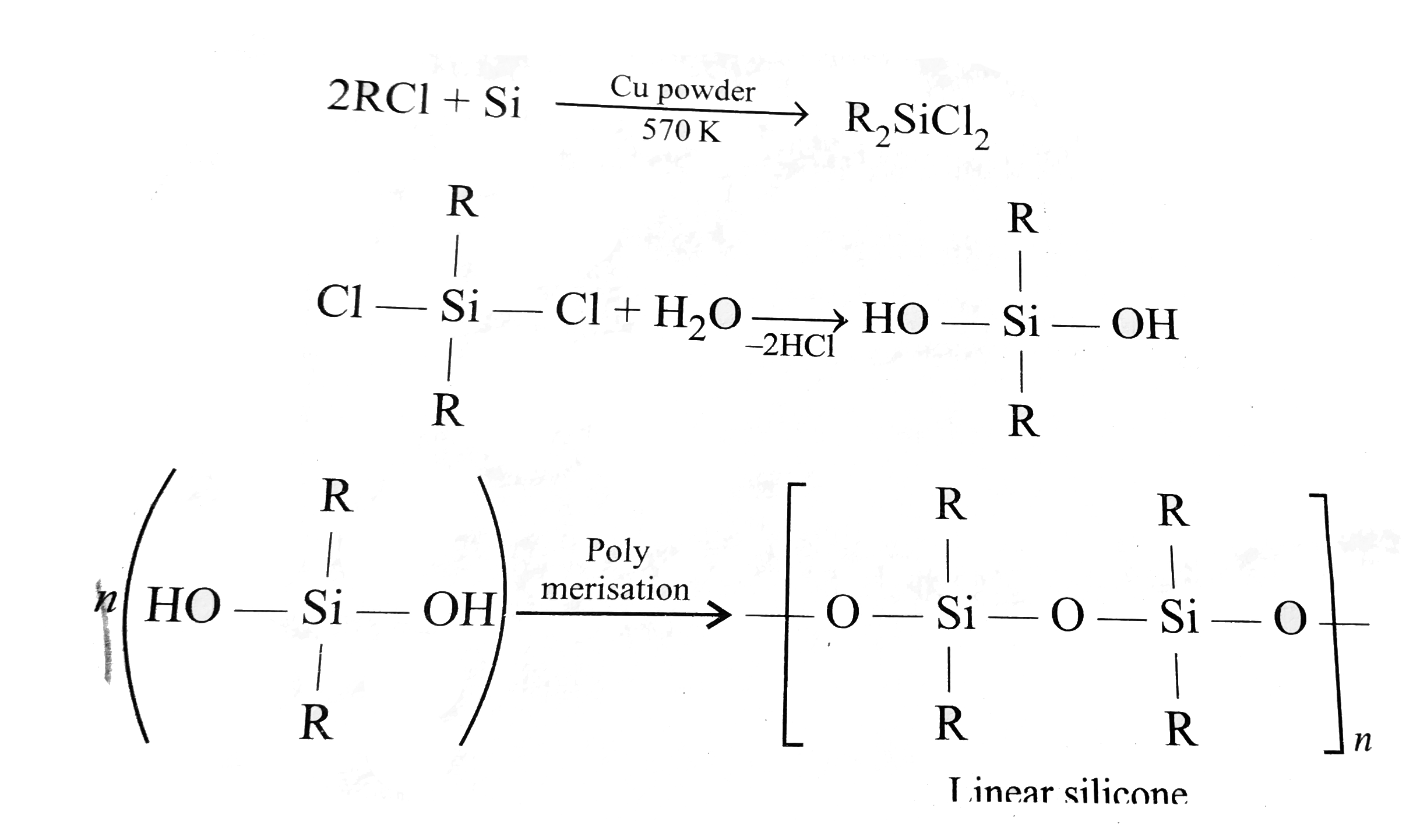Chooser the correct option :
a. A mixtrue of two fgasses is formed when an organic acid is heater with cons H2SO4 . When the gaseous mixture is passsed throughh KOH solution on gas is absorbed . The unabsorbed gas combines with chlorine and forms a posisonous gas . The organci acid and the two gases evolved with consc H2SO4 ar , respectively :
i. CH3COOH,CO2CO
ii , Oxalic acid , CO2,CO
ii.HCOOH,COH2O
iv. None of these
b)  .
.
(X) is
i. Cyclic silicon
ii. Cross -linkd slilcone
ii. Linear silicon
iv. None of these
c . Lead oxide PbO can be dissoveld in
i. HNO3, ii. HCliv, iii H2O.
d. A colourless slulution (A) gives halck precipitate on passing H2S . (A) also give a white precipitate with stannous chloride which graually changes to gvrey . Identigy (A) .
i. PbCl2
ii. CdBr2
iii. HgCL2
iv . Cu(NO3)2).
Video Solution
Text Solution
a. Opltion (ii) si correct .
Oxalic acid on heating with H2SO4 gives a mixture of two fases : CO2 and CO,H2SO4 acts as a dehydrating agent,

When this gasesous mixture , i.e. CO2 and CO, is passed through KOH,CO2 gets absorbed due to the formation of K2CO3 , wherease CO remains as such .
2KOH+CO2→k2CO3+H2O
CO combnines with Cl2 to form phosgene, COCl2 a poisonous gas . Thus , the organic acid and the two gases evlolved onm heating with conce H2SO4 are oxalic acid . CO2 and CO .
b. option (ii) is corrcet .
 .
.
c. Option (i) is correct .
Lead oxide . PbO, dissolves in HNO3 due to formation of lead intrate Pb(NO3)2 which si soluyble .
PbO+2HNO3→rPb(NO3)2+H2O
However in HCl,H2SO4 and H2O, it is insolble .
Pb+2HCl→PbCl2↓whiteppt.+H2O
Pb+2HCl→PbSO4↓whiteppt.+H2O
Pb+2HCl→Pb(OH)2⏐↓white ppt.+H2O
d. Option (iii) is correct .
(A) the sulphide formed by passing H2 s gas is black , hence it cannot be CdBr2 as CdS is yellow
Cd2++S2−→Cds↓Yellow
(A) also reacts with SnCl2 to give whith ppt ., wghich means (A) acts as on oxdiesing agent , oxidising
Sn2+→Sn4+ and itself it is redcued .
HgCl2+H2S→HgS↓Black ppt+2HCl
HgCl2+SnCl2→Hg2Cl2Whits +SnCl4
Hg2Cl2+SnCl2→2HgGrey+SnCl4 .
|
Topper's Solved these Questions
- P-BLOCK GROUP 14 - CARBON FAMILYBOOK - CENGAGE CHEMISTRYCHAPTER - P-BLOCK GROUP 14 - CARBON FAMILYEXERCISE - Ex (Subjective)
21 Videos
- P-BLOCK GROUP 14 - CARBON FAMILYBOOK - CENGAGE CHEMISTRYCHAPTER - P-BLOCK GROUP 14 - CARBON FAMILYEXERCISE - Ex (Objective)
19 Videos
- P-BLOCK GROUP 14 - CARBON FAMILYBOOK - CENGAGE CHEMISTRYCHAPTER - P-BLOCK GROUP 14 - CARBON FAMILYEXERCISE - Exercises Archives (Subjective)
9 Videos
- P-BLOCK GROUP 13 - BORON FAMILYBOOK - CENGAGE CHEMISTRYCHAPTER - P-BLOCK GROUP 13 - BORON FAMILYEXERCISE - Exercise Archives (Subjecive)
9 Videos
- PERIODIC CLASSIFICATION OF ELEMENTS AND GENERAL INORGANIC CHEMISTRYBOOK - CENGAGE CHEMISTRYCHAPTER - PERIODIC CLASSIFICATION OF ELEMENTS AND GENERAL INORGANIC CHEMISTRYEXERCISE - Exercises (Archives )Subjective
4 Videos
Similar Questions
Knowledge Check
What is formed when oxalic acid is dehydrated by conc.H2SO4 ?
AC+CO2BCOCCO2DCO+CO2What is formed when oxalic acid is dehydrated by conc. H2SO4 ?
AC+CO2BCOCCO2DCO+CO2When formic acid is heated with concentrated H2SO4, the gas evolved is
Aonly CO2Bonly COCa mixture of COandCO2Da mixture of SO2andCO2
Oxalic acid when heated with conc.H2SO4 it gives out
View SolutionWhen formic acid is heated with concentrated H2SO4, the gas evolved is
View SolutionWhen formic acid or oxalic acid is treated with conc. H2SO4 , the gas evolved is
View SolutionA mixture of 2.3 g formic acid and 4.5 g oxalic acid is treated with conc. H2SO4. The evolved gaseous mixture is passed through KOH pellets. Weight (in g) of the remaining product at STP will be
View SolutionWhen the nitrate is heated with conc. H2SO4, gas evolved is
View Solution
